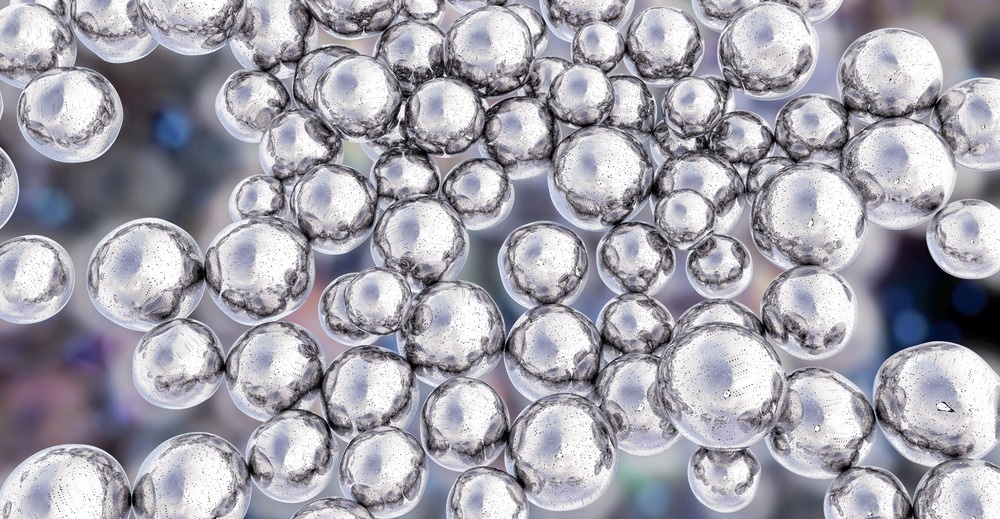A pre-proof study in the Journal of Aerosol Science employs a series of spark discharges in a flowing gas environment to repeatedly manufacture silver nanoparticles using the hydrogen-assisted spark generation technique. Various compositions of H2-Ar mixtures were used as the carrier gas to comprehensively study how the hydrogen concentration affects the signal amplification achieved with silver nanoparticles in Raman spectroscopic investigations.

Study: Hydrogen-assisted spark generation of silver nanoparticles: The effect of hydrogen content on the signal intensity in surface-enhanced Raman spectroscopy. Image Credit: Kateryna Kon/Shutterstock.com
The particles were gathered on filters and employed directly as SERS substrates. By incorporating at least 30% H2 into the Ar gas, a signal boost of about 50 times can be obtained.
Spark Ablation as Production Method of Non-Insulating Nanoparticles
Spark ablation is a simple, scalable, and adaptable technique for producing non-insulating nanoparticles (NPs) in the gas phase.
The quality of the nanoparticles produced is tightly controlled because spark ablation discharge nanoparticle generators are based on the intermittent ablation of electrode pairs in a controlled gaseous environment. Spark ablation produces pure NPs due to the lack of certain solvents and reagents.
Limitations of Oxygen Removal Techniques in Spark Ablation
Spark ablation inevitably contains some quantity of oxygen even while high purity forms of both carrier gases and bulk electrode materials are used. This results in oxide development, which is undesirable in some applications depending on the reactivity of the electrode material. Maintaining the ultra-high vacuum required by most physical vapor deposition methods to eliminate oxygen from the synthesis volume is impossible since spark ablation occurs in a flowing gas at atmospheric pressure.
It is possible to prevent oxidation in spark ablation discharge nanoparticle generators by using sample handling, stringent outgassing, and gas purification procedures while manufacturing silicon and magnesium NPs with no oxidation. However, this method makes the process extremely challenging, making it impractical to use it frequently for general purposes.
Strategy to Overcome Oxidation in Spark Ablation
Hydrogen is introduced to the carrier gas, functioning as a reducing agent during particle production to combat the oxidation problem. Hydrogen in the carrier gas lowers the formation of oxide primary particles in non-noble metals and facilitates the compaction of NP aggregates. As a result, adding hydrogen to the carrier gas during particle formation is an easy way to control the self-passivation and oxidation of aerosol NPs.
The inclusion of hydrogen is significant in the formation of crystalline alloys. Hydrogen addition boosts the resistance to oxidation of the produced particles during ambient storage. Even while the importance of a hydrogen-containing carrier gas has mostly been emphasized in the aerosol-based synthesis of non-noble metals, it can be pertinent for metals that are less prone to oxidation.
The Potential of Silver-based Surface-Enhanced Raman Spectroscopy Substrates
A few materials help generate the circumstances for resonant activation of surface plasmons and maximal signal augmentation. Gold and silver are the most frequently employed materials.
Due to its exceptional enhancement, silver is used in many applications. Silver is known to generate a thin surface oxide layer, which significantly affects its performance. This is even more crucial when fabricating silver-based surface-enhanced Raman spectroscopy substrates via aerosol approaches without stabilizing and protecting chemicals. The fabrication of surface-enhanced Raman spectroscopy substrates from silver on silicon wafers, optical fibers, microfiber filters, and dye films has shown great potential. Spark ablation is a prime example of such an aerosol approach.
Development of Hydrogen-Assisted Spark Generation of Silver Nanoparticles for Surface-Enhanced Raman Spectroscopy Substrate
Hydrogen is used in surface-enhanced Raman spectroscopy to increase the electrical field in nanostructures or nanostructured surfaces.
Kohut et al. produced silver NPs via hydrogen-assisted spark production and applied them directly from the aerosol phase to polyvinylidene fluoride (PVDF) filters. The silver-based filters were used to measure the Raman signal of a test analyte as surface-enhanced Raman spectroscopy substrates.
The researchers investigated the relationship between the hydrogen content and the signal enhancement produced by the manufactured substrates. The presence of hydrogen during the spark creation of silver NPs has a significant positive impact on their surface-enhanced Raman spectroscopy performance.
Research Findings
In this study, a process known as hydrogen-assisted spark generation was used to produce silver nanoparticles in the gas phase while systematically altering the hydrogen content of the Ar-H2 carrier gas.
Surface-enhanced Raman spectroscopy measurements were performed on an analyte dripped and dried on the filters' surface after collecting the produced particles on PVDF filters.
The impact of hydrogen content on the Raman spectroscopy signal enhancement was evaluated. The Ag nanoparticle enhancement factor increased almost 50 times when 30% or more H2 was used. The higher particle concentration, which leads to more pronounced aggregation and the production of hot spots for more efficient electric field amplification, was responsible for this augmentation.
The presence of hydrogen results in an extra 5-fold signal enhancement due to a decrease in the tendency of silver particles to develop a surface oxide layer during and after deposition. Results of non-oxidizable gold nanoparticles, which did not significantly alter the Raman signal independent of hydrogen presence, strengthened this argument.
Reference
Kohut, A. (2022) Hydrogen-assisted spark generation of silver nanoparticles: The effect of hydrogen content on the signal intensity in surface-enhanced Raman spectroscopy. Journal of Aerosol Science, 106090. https://www.sciencedirect.com/science/article/pii/S0021850222001264
Disclaimer: The views expressed here are those of the author expressed in their private capacity and do not necessarily represent the views of AZoM.com Limited T/A AZoNetwork the owner and operator of this website. This disclaimer forms part of the Terms and conditions of use of this website.